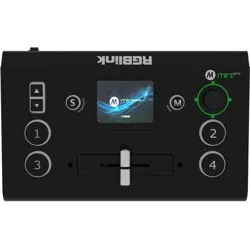Loading ...
Loading ...
Loading ...

© Xiamen RGBlink Science & Technology Co., Ltd.
Ph: +86 592 5771197
54
definition video, up to 8 channels of audio, and control signals, over a single cable.
●HDMI 1.3: Released on June 22 2006, and increased the maximum TMDS clock to 340 MHz (10.2 Gbit/s). Support
resolution 1920 × 1080 at 120 Hz or 2560 × 1440 at 60 Hz). It added support for 10 bpc, 12 bpc, and 16 bpc color depth
(30, 36, and 48 bit/px), called deep color.
●HDMI 1.4: Released on June 5, 2009, added support for 4096 × 2160 at 24 Hz, 3840 × 2160 at 24, 25, and 30 Hz, and
1920 × 1080 at 120 Hz. Compared to HDMI 1.3, 3 more features added which are HDMI Ethernet Channel (HEC) , audio
return channel (ARC),3D Over HDMI, a new Micro HDMI Connector, an expanded set of color spaces.
●HDMI 2.0: Released on September 4, 2013 increases the maximum bandwidth to 18.0 Gbit/s. Other features of HDMI
2.0 include up to 32 audio channels, up to 1536 kHz audio sample frequency, the HE-AAC and DRA audio standards,
improved 3D capability, and additional CEC functions.
●HDMI 2.0a: Was released on April 8, 2015, and added support for High Dynamic Range (HDR) video with static
metadata.
●HDMI 2.0b: Was released March, 2016, support for HDR Video transport and extends the static metadata signaling to
include Hybrid Log-Gamma (HLG).
●HDMI 2.1: Released on November 28, 2017. It adds support for higher resolutions and higher refresh rates, Dynamic
HDR including 4K 120 Hz and 8K 120 Hz.
●DisplayPort: A VESA standard interface primarily for video, but also for audio, USB and other data. DisplayPort (orDP)
is backwards compatible with HDMI, DVI and VGA.
●DP 1.1: Was ratified on 2 April 2007, and version 1.1a was ratified on 11 January 2008. DisplayPort 1.1 allow a
maximum bandwidth of 10.8 Gbit/s (8.64 Gbit/s data rate) over a standard 4-lane main link, enough to support
1920x1080@60Hz
●DP 1.2: Introduced on 7 January 2010, effective bandwidth to 17.28 Gbit/s support increased resolutions, higher
refresh rates, and greater color depth, maximum resolution 3840 × 2160@60Hz
●DP 1.4: Publish on 1 Mar, 2016.overall transmission bandwidth 32.4 Gbit/s ,DisplayPort 1.4 adds support for Display
Stream Compression 1.2 (DSC), DSC is a "visually lossless" encoding technique with up to a 3:1 compression ratio. Using
DSC with HBR3 transmission rates, DisplayPort 1.4 can support 8K UHD (7680 × 4320) at 60 Hz or 4K UHD (3840 × 2160)
at 120 Hz with 30 bit/px RGB color and HDR. 4K at 60 Hz 30 bit/px RGB/HDR can be achieved without the need for DSC.
●Multi-mode Fiber: Fibers that support many propagation paths or transverse modes are called multi-mode fibers,
generally have a wider core diameter and are used for short-distance communication links and for applications where
high power must be transmitted.
●Single-mode Fiber: Fiber that support a single mode are called single-mode fibers. Single-mode fibers are used for
most communication links longer than 1,000 meters (3,300 ft).
●SFP: Small form-factor pluggable , is a compact, hot-pluggable network interface module used for
both telecommunication and data communications applications.
Loading ...
Loading ...
Loading ...
